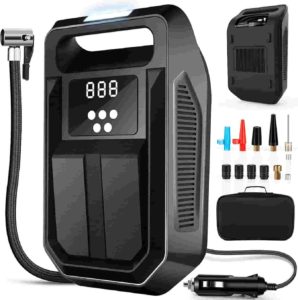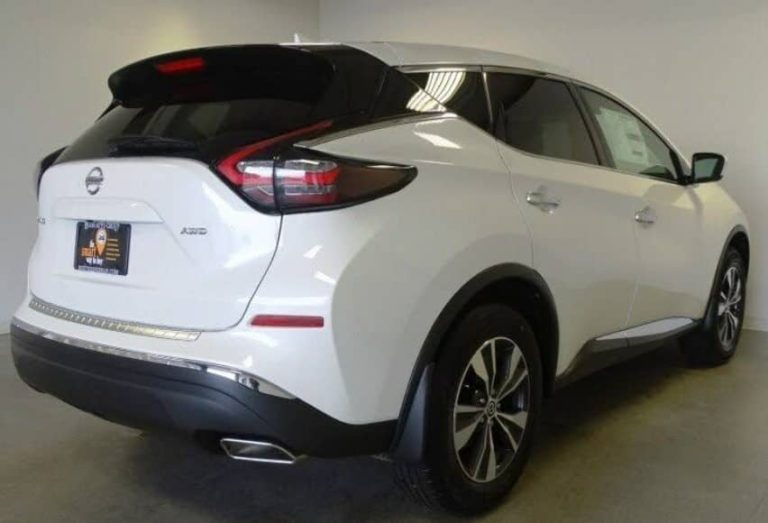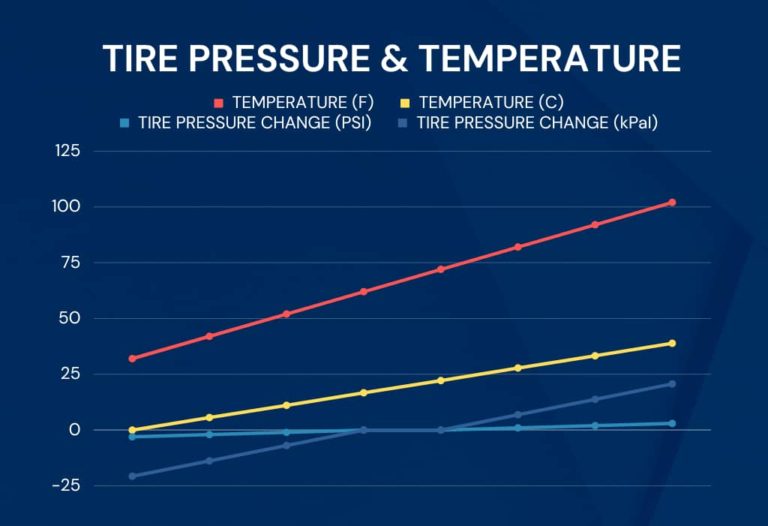How to Reset the Nissan Murano Tire Pressure Light
The Nissan Murano does not have a tire pressure reset button.
Park the vehicle in a safe place and turn the engine off.
Adjust the tire pressure in all four tires to the recommended COLD tire pressure, 33 OR 35 Psi depending on tire sizes. (check chart above)
After adjusting the tire pressure, drive the vehicle at speeds above 16 MPH (25 km/h). The low tire pressure warning light does not automatically turn off when the tire pressure is adjusted. After the vehicle speed reaches 16 MPH (25 km/h), the light will turn off.
If the low tire pressure warning light flashes for approximately 1 minute and then remains on after you turn the ignition switch to the ON position, the TPMS is not functioning properly. (read more about TPMS malfunction below)
If the light doesn’t go off right away, re-check your tire pressure to make sure they are all at the exact pressure you set them to. If the pressure has decreased, you probably have some sort of leak in that tire.
If your tires are not losing air and the tire light still won’t go out, try overfilling your tires by about 10 Psi. So, fill them to 45 Psi and then drive the car for a few minutes. The tire light should reset. Remember: DO NOT leave the tires at this level, release the extra 10 Psi afterwards.
NOTE: The tire pressure monitoring system (TPMS) will not turn off the low tire pressure warning light until the tire pressure is set to the recommended pressure and the vehicle is driven at speeds above 16 MPH (25 km/h). If you’ve completed these steps and the tire light STILL won’t go out, There is only one of three things that can be the problem. Either have a faulty tire pressure sensor in one of your wheels OR you have a leak OR your receiver module (control unit) is not communicating with your sensors (this is the least of all likely and is rare).
2023 Nissan Murano Tire Pressures:
TIRE SIZE | FRONT PSI | REAR PSI |
235/65R18 | 33 | 33 |
235/55R20 | 35 | 35 |
SPARE TIRE | 60 | 60 |
What is the TPMS in the Nissan Murano?
Have you ever experienced that sinking feeling of “Not this again!” when the tire pressure light flashes on your dashboard? It’s time to view this little light with gratitude! In your Nissan Murano, this is the handiwork of the Tire Pressure Monitoring System (TPMS), acting as a vigilant protector for your vehicle. This system diligently monitors the pressure in all four tires, ensuring they’re neither too full nor too flat. The TPMS is dedicated to safety, performance, and efficiency. It’s the quiet guardian of your vehicle’s maneuverability and braking capabilities, ensuring they’re never jeopardized. So, the next time the light flicks on, remember – it’s your TPMS, enhancing your driving experience to be safer, smoother, and more efficient! In this article, we will guide you on how to reset your low tire light, elaborate on how your TPMS functions, and explain why your tire light might be on!
Tire Settings
How to Reset the Tire Maintenance Light
Apply the parking brake.
Turn the ignition switch to the ON position, but do not start the engine.
Use the steering wheel switches to select the “Settings” menu on the vehicle information display.
Select “Maintenance“.
Select “Tire”
Select “Reset“, then “Yes“.
The tire maintenance indicator light will turn off.
How to Change Tire Pressure Units
Turn the ignition switch to the ON position, but do not start the engine.
Use the steering wheel switches to select the “Settings” menu on the vehicle information display.
Select “TPMS Settings“.
In the menu, you will find the “Pressure Unit” option. Press the “OK” button to select it.
You can now choose between PSI (Pounds per Square Inch), kPa (Kilopascal), or bar. Use the arrow buttons to select your preferred unit and press the “OK” button to confirm your selection.
The tire pressure units have now been changed. You can press the “BACK” button to exit the menu.
How Does the Nissan Murano TPMS Work?
The Nissan Murano’s tire pressure monitoring system (TPMS) is a smart system that checks the air pressure in your tires. Let’s look at how it works:
Sensors: The TPMS sensors, also known as transducers, are located inside each tire as a part of the valve stem. These sensors are battery-powered and are designed to measure the air pressure within the tire. They can also detect the temperature inside the tire, which can affect the pressure readings. The sensors are sealed units, and when the battery dies (typically after several years), the entire sensor unit has to be replaced.
Data Transmission: Each sensor transmits the tire pressure data wirelessly to the TPMS control module, a dedicated electronic device inside the vehicle. This transmission occurs via radio frequency signals. The sensors transmit data while the vehicle is in operation, ensuring live monitoring of tire pressure. The control module is designed to recognize the unique signal (each sensor has a unique ID number) from each sensor, allowing it to monitor the pressure in each tire individually.
Data Analysis: The TPMS control module is programmed with Nisan’s recommended tire pressure levels for the Murano. When it receives data from the sensors, it compares the actual tire pressure readings with these recommended levels. If the pressure in any tire is detected to be outside of the acceptable range (either too high or too low), the system determines that there is a problem.
Alerts: When the TPMS identifies a tire pressure issue, it triggers an alert to the driver. This is done by illuminating a warning light on the vehicle’s dashboard. The warning light is a universal symbol that looks like a yellow exclamation point inside a tire. The Murano TPMS also provides a text alert on the vehicle information display, indicating which tire is under or over-inflated. This allows the driver to address the specific tire issue promptly.
What is the TPMS Malfunction Indicator?
The Nissan Murano’s tire pressure monitoring system also has a way of letting you know when something is wrong with the system itself, called the TPMS malfunction indicator. The indicator uses the same yellow exclamation point as the low tire pressure light. The difference is that, if there is a problem with the system, the light will flash for approximately 60 seconds before staying on. The flashing or blinking will happen every time you start your Murano until the issue is resolved. When your tire light is flashing your Nissan Murano will not be able to give you accurate pressure readings. Basically, a blinking tire pressure light means there is a malfunction within the TPMS itself, rather than an air pressure issue. This is usually due to a faulty pressure sensor in one of your tires (a dead battery) or driving with the spare tire. (if the spare doesn’t have a sensor in it) To figure out which sensor is malfunctioning or faulty, use a TPMS diagnostic tool and scan each sensor for diagnostic information or bring your car to a professional.
Why is the TPMS Malfunctioning?
Using non Nissan wheels or tires sizes.
Devices that function on comparable radio frequencies can disrupt the operation of the Tire Pressure Monitoring System (TPMS), leading to it not working as intended. This disruption can originate from a variety of sources, even from seemingly innocuous devices such as a radio or the security system of a nearby store.
If your Murano’s windows are heavily tinted, it could potentially interfere with the radio signals being transmitted between the TPMS sensors and the receiver.
In the event of substantial snow or ice accumulation on or surrounding the tire valves
Driving with the spare tire on (if it does not have a sensor in it)
If the tire pressure is extremely high.
If wheels without tire pressure sensors are installed on the car.
If new tire pressure sensors are fitted without syncing the new sensor IDs with the Murano’s receiver module or ECU.
What Can Cause the Tire Light to Turn On?
Seasonal temperature changes: A decline in the surrounding temperature may lead to a reduction in tire pressure, activating the warning indicator.
Tire puncture or leak: An object with a sharp edge such as nails or screws, could penetrate your tires. This will result in air leakage, which will inevitably set off the warning light.
Faulty tire pressure sensor: Damaged or malfunctioning sensors may provide inaccurate readings, resulting in a false alert. The only way to determine which sensor is faulty is to scan each sensor with a TPMS diagnostic tool.
Valve stem issues: A damaged or leaking valve stem can lead to gradual pressure loss and eventual activation of the tire pressure light. They make kits to replace the rubber gasket that usually goes bad over time.
Tire damage: Impact from potholes or hitting a curb can cause structural damage like tire bubbles, leading to pressure loss.
Sensor battery life: TPMS sensors are battery-powered, and over time, batteries die. (they usually last anywhere from 5-10 years) This will cause the tire pressure light to turn on. Again, you must use a diagnostic tool to determine which sensor is dead or dying.
Recent tire rotation or replacement: If the tires have been recently rotated or replaced, the TPMS may need recalibration to avoid false alerts. After a tire rotation, the vehicle’s computer could mistakenly assume that the front tires are at the back and the back tires are at the front.
Wheel or rim issues: Damaged, corroded, or cracked wheels or rims can lead to air leaks and pressure loss. This is very common with low profile tires.
Altitude changes: Climbing or descending in elevation can affect tire pressure and trigger the TPMS warning. There is a requirement for an additional 1.5 Psi per kilometer above sea level.
Natural pressure loss: Tires lose air pressure over time due to temperature changes and permeation. Tire dry-rot will happen to tires that sit.
Electrical problems or software issues within the car’s TPMS system. Occasionally the system may have a software update from Nissan.
Snow Tires: If you have a second set of wheels or rims for your winter tires, you have the option to either swap the sensors from your summer wheels or purchase an extra set of four sensors for the secondary set of wheels or rims. However, if you use the same wheels for both tire sets, this isn’t something you need to worry about.
What are the Effects of Underinflated or Overinflated Tires?
When tires are underinflated or overinflated in your Nissan Murano, several issues can arise:
Underinflated Tires:
Decreased Fuel Efficiency: Underinflated tires create more resistance, causing the engine to work harder and consume more fuel.
Reduced Handling and Stability: Underinflation can affect the car’s steering and overall stability, making your steering erratic and harder to control.
Increased Tire Wear: The excess friction between the road and an underinflated tire causes faster tire tread wear, which means tires will need to be replaced sooner.
Greater Risk of Tire Damage: Underinflated tires are more susceptible to damage, such as punctures or tire blowouts.
Overinflated Tires:
Diminished Traction: Overinflated tires have a smaller contact patch with the road surface, reducing traction and grip.
Uncomfortable Ride: Overinflation makes tires harder, resulting in a more uncomfortable ride as they’re less capable of absorbing road shocks.
Increased Tire Wear: Overinflation can cause the middle section of the tire to wear faster than the edges.
Greater Risk of Tire Damage: Overinflated tires are more susceptible to damage from road hazards or potholes.
Does the Weather Affect Tire Pressure?
Fluctuations in weather conditions have a substantial impact on tire pressure due to the way air expands or contracts with temperature changes. In warmer climates, the air inside a tire tends to expand, which will result in increased tire pressure. On the other hand, in colder weather, the air contracts, leading to a decrease in tire pressure. Rain and humidity can also have a minor influence, potentially leading to slight variations in pressure. A common rule of thumb suggests that for every 10-degree Fahrenheit shift in temperature, tire pressure will adjust by about 1 psi, either increasing or decreasing.
How to Check & Adjust Tire Pressure
Make sure the tires are cold. If your vehicle has been driven, wait at least three hours before checking the tire pressure.
Remove the valve cap from the tire.
Press the tip of the tire pressure gauge onto the valve and read the pressure.
If the tire pressure is below the recommended level, fill the tire with air until the recommended pressure is reached. If the tire pressure is above the recommended level, release air until it reaches the recommended pressure. (Press the metal stem in the center of the tire valve. You can use any object like a screwdriver to do this. Be gentle.)
After adjusting the tire pressure, don’t forget to put the valve caps back on to prevent leaks and keep dirt and moisture out.
Repeat this process for each tire, including the spare if applicable.
When is the Best Time to Adjust Tire Pressure?
For a precise tire pressure check on your Nissan Murano, do it when your car has been parked for some time, ideally in the morning. This is called checking the “cold pressure” after the car hasn’t moved for about three hours or more. Driving warms up your tires, making the air inside them increase, which can show falsely high pressure readings. So, don’t adjust your tire pressure right after driving, you’ll end up with overinflated tires!
Conclusion
Your Nissan Murano’s tire pressure monitoring system is a crucial component that ensures safety and efficiency while you navigate the roads. Understanding and maintaining the correct tire pressure is not just about avoiding that pesky light on your dashboard; it’s about securing optimal vehicle performance, enhancing fuel economy, and most importantly, keeping you and your passengers safe. So the next time you hop into your car, remember the silent but vigilant hero that is the TPMS, and ensure it’s in top working condition. Drive safe and enjoy the ride! Everything in this article is applicable to all Nissan Murano models and trims. Including Murano FWD & AWD, Murano S, Murano SV, Murano Midnight Edition, Murano SL, and Murano Platinum.
Please note that this blog post contains Amazon affiliate links. This means that if you make a purchase through one of these links, we at TPMSRESET.com may earn a small commission at no extra cost to you. We only recommend products that we personally use and believe in. Thank you for supporting us.






